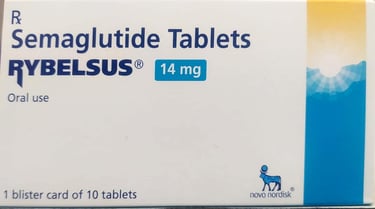Add your promotional text...
5 Must Know Things About Semaglutide
A quick guide on important questions, before you start Semaglutide, a GLP1 Receptor Agonists, that helps in lowering blood sugar and reducing weight.
MEDICINES
8/24/20244 min read
Semaglutide has gained attention for its effectiveness in managing type 2 diabetes and supporting weight loss. Whether you're considering this medication or have recently started using it, here are five key things you need to know.
1. How Semaglutide Works?
Semaglutide is a GLP-1 receptor agonist, meaning it mimics the action of the glucagon-like peptide-1 hormone in your body. It works by:
Stimulating Insulin Production: When your blood sugar levels rise, semaglutide helps your pancreas release more insulin, which lowers blood glucose levels.
Reducing Glucagon Release: It decreases the secretion of glucagon, a hormone that increases blood sugar levels, helping to maintain a balanced glucose level.
Slowing Digestion: By delaying gastric emptying, semaglutide helps you feel full longer, which can reduce your appetite and aid in weight management.
2. Can Semaglutide be used beyond Diabetes?
While semaglutide is primarily used to manage type 2 diabetes, it has also been approved for chronic weight management in adults who are overweight or obese. Clinical trials have shown that semaglutide can significantly reduce body weight, making it a valuable option for those struggling with obesity, especially when combined with diet and exercise.
3. What are the forms available and what is the dosing?
Semaglutide comes in two forms:
Injectable Form: Administered once weekly, this form is used for both diabetes management and weight loss. The injection is typically given under the skin of the abdomen, thigh, or upper arm.
Oral Form: This daily tablet is primarily for managing type 2 diabetes. It should be taken on an empty stomach with a small amount of water, at least 30 minutes before eating or drinking anything else.
The dosing of semaglutide is carefully selected based on the you medical condition, treatment goals, and how you respond to the medication. Here’s how healthcare providers typically determine the appropriate dose:
Starting Dose
Low Initial Dose: Treatment usually begins with a low dose to allow the body to adjust to the medication and to minimize side effects, particularly gastrointestinal issues like nausea. For example, the initial dose might be 0.25 mg once weekly for the injectable form or 3 mg daily for the oral form.
Duration: This starting dose is typically maintained for a few weeks (often four weeks) before considering an increase.
Titration to Therapeutic Dose
Gradual Increase: After the initial period, the dose is gradually increased to a therapeutic level. For the injectable form, the dose might be increased to 0.5 mg once weekly, and then further adjusted to 1 mg or 2 mg weekly, depending on the patient’s needs and tolerability.
For Weight Management: If semaglutide is being used for weight loss, the dose might be titrated up to a higher level, such as 2.4 mg weekly.
Note, if you remember soon after missing the dose and it's within 12 hours of your usual dosing time, take the tablet as soon as you can.
If it's been more than 12 hours since your usual dosing time, skip the missed dose. Do not take an extra dose or double up on your next dose to make up for the missed one.
Missing a dose of semaglutide occasionally isn’t likely to cause significant problems, but it’s important to take the medication consistently to maintain its effectiveness. If you often forget doses, consider setting reminders or using a pill organizer to help keep track.
4. Possible Side Effects
Like all medications, semaglutide can have side effects. Common ones include:
Gastrointestinal Issues: Nausea, vomiting, diarrhea, and constipation are the most common side effects, particularly when starting the medication. These often diminish as your body adjusts.
Serious Risks: There is a risk of more severe side effects, such as pancreatitis, gallbladder problems, or an increased heart rate. If you experience severe or persistent symptoms, contact your healthcare provider immediately.
5. The Importance of Lifestyle Changes
Semaglutide is most effective when combined with a healthy lifestyle. This means following a balanced diet and engaging in regular physical activity. While the medication helps control blood sugar and aids in weight loss, sustainable results are best achieved by adopting healthy habits.
Conclusion
Understanding these five essential aspects of semaglutide can help you make informed decisions about your treatment. Whether you're managing type 2 diabetes, looking to lose weight, or both, knowing how semaglutide works, its uses, potential side effects, and the importance of lifestyle changes can empower you to take control of your health. Always consult with your healthcare provider to ensure semaglutide is right for you and to develop a comprehensive treatment plan tailored to your needs.








